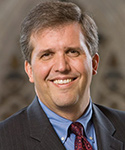We long for elegant design in our most treasured spaces: museums, cathedrals, houses, town squares, even our modes of transportation. We are astonished by elegant design we find in the natural world, such as mathematical equations and symmetrical patterns of snowflakes and waves and human physiology. We are drawn to the extraordinary beauty of da Vinci’s “Mona Lisa” or Michelangelo’s “David.”
Our longing for elegant design is rooted in the doctrine of creation and the experience of Easter. We yearn for the transcendent connections to God and God’s loving, creative purposes found in the beauty, order and mystery of human accomplishment, the natural world and the human body.
We yearn for that elegance found in Christ’s dying and rising.
Less noticed, perhaps, is our longing for God, and for elegance, in the design of our institutions. The question is not whether we will organize ourselves; it is whether we will do so well or badly. We yearn for institutions -- including those in the social sector -- that will function with what Matthew E. May, in his book “In Pursuit of Elegance,” calls “effortless effectiveness”: an ability to achieve maximum effect with minimal effort.
We marvel at corporations, such as Apple, that offer such effectiveness. Apple combines identity and innovation, efficiency and creativity, functionality and beauty. Such organizations attend to the design of the physical spaces they occupy, to be sure, but elegant design is more than that. It involves attending to the design of people’s time and development, the design of ideas, the design of services, the design of networks and the design of budgets.
One of the key marks of elegant design is sustainability over time. As May notes, “to be sustainable, any given asset, no matter what it is, must be kept whole, without making significant trade-offs that undermine the capital used to generate and maintain it.” He further adds that sustainability “hinges on the ability to see finite resources as the very source of innovation.”
Christian institutions are more often focused on solving short-term problems than on designing sustainable, elegant organizational ecosystems that can accomplish the work that brought those institutions into being. We focus on short-term efficiency rather than long-term effectiveness. We become obsessed with short-term fundraising appeals to keep the doors open, or we rely on a small handful of wealthy “angels” to keep underwriting what would otherwise be an unsustainable business plan.
What is involved in sustainable design? It depends on a logic of abundance, namely, that vibrant institutions are responsive to God’s abundant provision in creation. Equally important, such abundant provision from God is accompanied by attentiveness to those human processes of design and efficiency that lead to generative organization.
Sustainable design requires attention to money at the beginning of and throughout planning, but in ways different from typical fundraising strategies. The attention to money must be woven into the development of other forms of capital to enable organizations to be sustainable over the long term.
Laura Nichol’s description of “four forms of capital” insightfully illumines the interrelated dynamics that go into long-term sustainability. Nichol shows how organizations can generate greater financial capital by focusing attention also, and to an extent more determinatively, on three other forms of capital: intellectual, network and service capital.
We suggest that there is a fifth form that undergirds and envelops the strategic choices that an organization makes: human capital.
All five forms of capital are critical to cultivating sustainability over time. People are likely to be invested in organizations, and to discover that those organizations are vibrant, to the degree that they participate in the contributions those organizations are making to human flourishing. Such contributions might include addressing critically important problems, cultivating important opportunities and innovation, or enabling truth, goodness and beauty to be discovered in profoundly new ways.
People invest in organizations:
- By their own engagement as staff or as volunteers (human capital).
- By conserving wisdom and cultivating new ideas (intellectual capital).
- By providing opportunities for others to solve problems or experience development (service capital).
- By connecting with other people and organizations who care about similar issues and themes (network capital).
- By making contributions and encouraging others to provide financial support for the organization to sustain its current budget, as well as for it to dream about new possibilities (financial capital).
Each organization needs to make strategic choices about how to develop each form of capital. The stronger the attention to developing human talent within the organization and in its boards, the more likely the organization will be to develop intellectual, service, network and financial capital. And so on.
The sustainability of Christian institutions depends on a healthy ecosystem of organizations. Congregations and pastors do not exist in isolation; they need, for example, educational organizations, healing organizations to care for those who are sick, and spaces to pay attention to the particular needs of young people and older generations. Those institutions, in turn, need healthy and vital congregations and pastors.
The sustainable design of Christian institutions looks both inward at their generative organization and outward at their role in the broader ecological contexts that contribute to the flourishing of all the institutions in that ecology.
For example, some organizations may play a “keystone” role in an overall Christian ecosystem -- a college and seminary within a small denomination, for example. In other cases, transformative leaders might become what Steven Johnson calls “ecological engineers,” developing new ecosystems of organizations through traditioned innovation.
When we are fundamentally responding to God’s generous provision, we are then able to think about the design of our institutions from a position of abundance rather than scarcity, and to think about ecosystems rather than regarding our institutions or others as stand-alone competitors for precious philanthropic dollars.
Such a commitment leads us to be aware of those resources and relationships that are necessary for both short-term stability and long-term fruitfulness.








